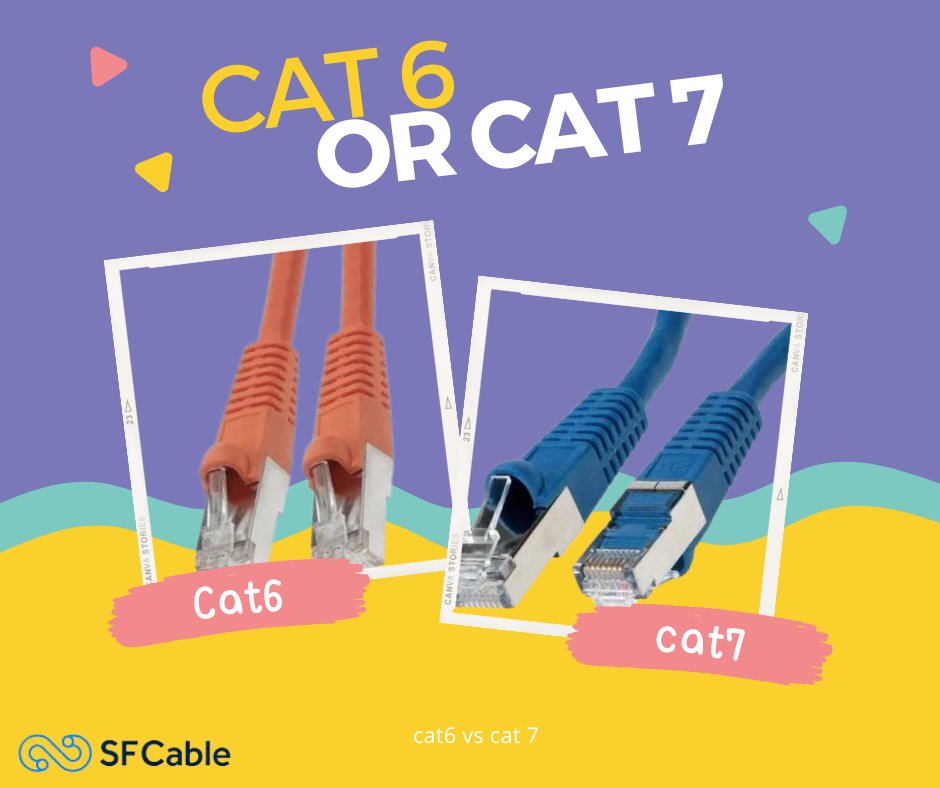Understanding the Differences Between Cat6 and Cat7 Ethernet Cables
Devices are able to communicate with one another over a physical connection thanks to the use of Ethernet cords, which are the fundamental component of current networking technology.

Devices are able to communicate with one another over a physical connection thanks to the use of Ethernet cords, which are the fundamental component of current networking technology. There is more than one kind of Ethernet cords available, and each of these cables has a unique set of capabilities and benefits. This article will discuss the distinctions between Cat6 and Cat7 cables, which are currently the most widely used kind of Ethernet cables.
Cat6 Ethernet Cable
Cat6 Ethernet connections are widely used in both home and business networks. These cables can carry data at speeds of up to 10 Gbps for distances of up to 55 metres. Cat5 and Cat5e Ethernet cables are supported, making this a simple update for preexisting networks.
Advantages of Cat6 Ethernet Cable
- Cat6 Ethernet connections provide low crosstalk, or interference, between wires, which is a significant benefit. A decrease in electrical interference is obtained by tightening the cable's twists. The sheath of Cat6 Ethernet cables is often thicker than earlier versions, giving increased protection against damage and wear.
- Cat6 Ethernet cables also have the advantage of being relatively cheap. Compared to other types of high-speed Ethernet cables, including Cat7 or fibre optic cables, they tend to be more cost-effective. As a result, they are a good choice for startups and people who want to update their home networks without breaking the budget.
However, Cat6 Ethernet cables do have their limitations. While they can support high-speed data transfer over short distances, Cat7 cables are less effective for longer distances and high levels of interference. There may be better choices for more extensive commercial networks or high-performance applications.
Cat7 Ethernet Cable
Cat7 Ethernet cables are faster and more interference-resistant than Cat6 cables. These cables provide 10 Gbps data transfer over 100 metres. They are insulated to reduce EMI and RFI (RFI).
Advantages of Cat7 Ethernet Cable
- One of the critical advantages of Cat7 Ethernet cables is their ability to support even higher data transfer speeds than Cat6 cables. It is achieved through tighter twists and a thicker sheath, which reduce crosstalk and improve signal quality. Additionally, the shielded design of Cat7 cables provides even better protection against interference, making them an ideal choice for high-performance networking applications.
- Another benefit of Cat7 Ethernet cables is their future-proofing capabilities. These cables are designed to support data transfer speeds of up to 100 Gbps, significantly faster than most current networking standards. It makes them a wise investment for businesses and individuals who want to ensure their network infrastructure can handle future technological advancements.
Comparison of Cat6 and Cat7 Ethernet Cables
- There are a few notable distinctions when contrasting Cat6 with Cat7 Ethernet cables. To begin, Cat7 cables are capable of faster data transfer rates and longer cable runs than their predecessors, Cat6 cables. Because of this, they are preferable for any application where high-performance networking is required, be it a business or an individual's home network.
- Second, interference is less of a concern when using Cat7 connections than Cat6 cables. A shielded layout accomplishes this, enhancing protection from EMI and RFI. Although Cat6 cables offer some shielding from interference, they are less effective than Cat7 connections.
- Cat6 Ethernet cables are a cost-effective choice for small businesses or individuals looking to upgrade their home network. They offer high-speed data transfer over short distances and reduced interference through tighter twists and a thicker sheath. However, better choices for more extensive commercial networks or high-performance applications may exist.
- On the other hand, Cat7 Ethernet cables are designed for high-performance networking applications. Their shielded design offers even higher data transfer speeds and improved protection against interference. Additionally, they are future-proofed to support data transfer speeds of up to 100 Gbps, making them a wise investment for businesses or individuals who want to ensure their network infrastructure can handle future technological advancements.
- Finally, Cat7 cables are more expensive than Cat6 cables. This is due to their higher performance capabilities and improved shielding design. However, for businesses or individuals who require the highest level of networking performance and protection, the added cost may be worth it.
Conclusion
Ethernet cables rated Cat6 and Cat7 are two popular options for high-speed networking applications; nevertheless, each has a unique set of benefits and drawbacks.
If you want to improve your network's infrastructure, sfcable.com is an excellent location to begin your search. In addition to our extensive inventory of Ethernet cables, which includes both Cat6 and Cat7 alternatives, we also provide knowledgeable guidance to assist you in making an educated choice. By selecting the Ethernet cable most appropriate for your network, you can ensure it has the speed and stability it needs to be connected and productive in today's fast-paced digital world.
What's Your Reaction?




















